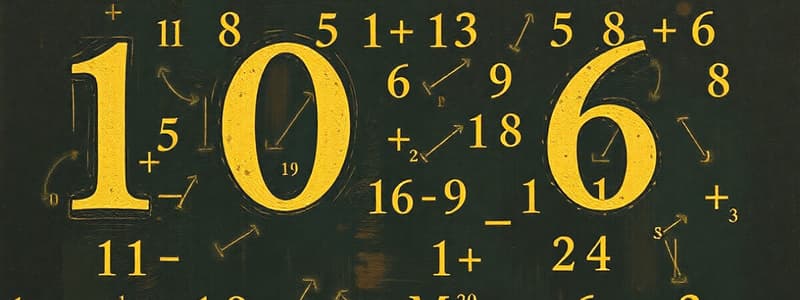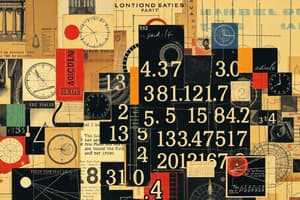Podcast
Questions and Answers
Which trigonometric ratio is defined as the opposite side divided by the hypotenuse of a right triangle?
Which trigonometric ratio is defined as the opposite side divided by the hypotenuse of a right triangle?
- Cosine
- Secant
- Sine (correct)
- Tangent
Calculus is primarily concerned with discrete data and countable objects.
Calculus is primarily concerned with discrete data and countable objects.
False (B)
What is the term used to describe the average value of a data set?
What is the term used to describe the average value of a data set?
mean
In statistics, the measure of how much the data diverges from the average is called ______.
In statistics, the measure of how much the data diverges from the average is called ______.
Match the following concepts in discrete mathematics to their descriptions:
Match the following concepts in discrete mathematics to their descriptions:
Which of the following sets includes zero?
Which of the following sets includes zero?
Rational numbers can only be expressed as terminating decimals.
Rational numbers can only be expressed as terminating decimals.
What is the form of a complex number?
What is the form of a complex number?
The distance around a two-dimensional shape is called the ______.
The distance around a two-dimensional shape is called the ______.
Match the following types of numbers with their definitions:
Match the following types of numbers with their definitions:
Which operation is performed first according to the order of operations?
Which operation is performed first according to the order of operations?
A triangle is classified as a polygon with four sides.
A triangle is classified as a polygon with four sides.
What do you call the expression that states two quantities are equal?
What do you call the expression that states two quantities are equal?
Flashcards
What is trigonometry?
What is trigonometry?
Trigonometry is the study of relationships between the angles and sides of triangles. It uses trigonometric ratios (sine, cosine, tangent) to relate angles to side ratios, explores trigonometric identities (equations true for all angle values), and finds applications in solving triangles, navigation, and surveying.
What are similar figures?
What are similar figures?
Similar figures are geometric figures that have the same shape but may have different sizes. They maintain the same proportions between corresponding sides and angles.
What is Calculus?
What is Calculus?
Calculus deals with continuous change. It uses limits to understand a function's behavior as its input approaches a specific value, derivatives to measure the rate of change of a function, and integrals to calculate accumulated change. Applications include finding slopes, areas, volumes, and rates of growth and decay.
What is Statistics?
What is Statistics?
Signup and view all the flashcards
What is discrete mathematics?
What is discrete mathematics?
Signup and view all the flashcards
Rational Numbers
Rational Numbers
Signup and view all the flashcards
Irrational Numbers
Irrational Numbers
Signup and view all the flashcards
Complex Numbers
Complex Numbers
Signup and view all the flashcards
Polynomial
Polynomial
Signup and view all the flashcards
Solving Equations
Solving Equations
Signup and view all the flashcards
Polygon
Polygon
Signup and view all the flashcards
Perimeter
Perimeter
Signup and view all the flashcards
Area
Area
Signup and view all the flashcards
Study Notes
Number Systems
- Natural numbers are the counting numbers (1, 2, 3,...).
- Whole numbers include zero and all natural numbers (0, 1, 2, 3,...).
- Integers are whole numbers and their negative counterparts (..., -3, -2, -1, 0, 1, 2, 3,...).
- Rational numbers can be expressed as a fraction p/q, where p and q are integers and q is not zero. Examples include fractions, terminating decimals (e.g., 0.5), and repeating decimals (e.g., 0.333...).
- Irrational numbers cannot be expressed as a fraction of two integers. Examples include √2 and π.
- Real numbers encompass all rational and irrational numbers.
- Imaginary numbers are numbers containing the imaginary unit 'i', where i² = -1.
- Complex numbers are numbers in the form a + bi, where 'a' and 'b' are real numbers and 'i' is the imaginary unit.
Arithmetic Operations
- Addition (+) combines two or more numbers to find a sum.
- Subtraction (-) finds the difference between two numbers.
- Multiplication (× or *) combines numbers repeatedly.
- Division (÷ or /) separates a number into equal parts.
- Order of operations (PEMDAS/BODMAS): Parentheses/Brackets, Exponents/Orders, Multiplication and Division (from left to right), Addition and Subtraction (from left to right).
Algebra
- Variables represent unknown quantities.
- Equations state that two expressions are equal.
- Inequalities show that one expression is greater than or less than another.
- Linear equations have the form y = mx + b, where 'm' is the slope and 'b' is the y-intercept.
- Quadratic equations have the form ax² + bx + c = 0, where 'a', 'b', and 'c' are constants.
- Polynomials are expressions consisting of variables and coefficients.
- Factoring is expressing a polynomial as a product of simpler polynomials.
- Solving equations involves finding the value(s) of the variable(s) that make the equation true.
- Systems of equations involve multiple equations with multiple variables.
Geometry
- Points, lines, and planes are fundamental geometric objects.
- Angles are formed by two rays sharing a common endpoint.
- Polygons are closed figures with straight sides.
- Triangles are polygons with three sides.
- Quadrilaterals are polygons with four sides.
- Circles are sets of points equidistant from a center point.
- Perimeter is the distance around a two-dimensional shape.
- Area is the space enclosed by a two-dimensional shape.
- Volume is the amount of space occupied by a three-dimensional object.
- Congruent figures have the same shape and size.
- Similar figures have the same shape but not necessarily the same size.
Trigonometry
- Trigonometry deals with relationships between angles and sides of triangles.
- Trigonometric ratios (sine, cosine, tangent) relate angles to ratios of sides.
- Trigonometric identities are equations that are true for all values of the variables.
- Applications of trigonometry include solving triangles, navigation, and surveying.
- Understanding of right angled triangles is important.
Calculus
- Calculus deals with continuous change.
- Limits determine the behavior of a function as its input approaches a specific value.
- Derivatives measure the rate of change of a function.
- Integrals calculate accumulated change.
- Applications include finding slopes, areas, volumes, and rates of growth and decay.
Statistics
- Statistics involves collecting, organizing, analyzing, interpreting, and presenting data.
- Measures of central tendency (mean, median, mode) describe the center of a data set.
- Measures of dispersion (variance, standard deviation) describe the spread of a data set.
- Probability measures the likelihood of events occurring.
- Data visualization tools (graphs, charts) help in understanding data patterns.
Discrete Mathematics
- Discrete mathematics focuses on countable objects.
- Topics include set theory, logic, graph theory, combinatorics, and discrete probability.
- Set theory deals with collections of objects.
- Combinatorics deals with counting and arranging objects.
- Graph theory involves studying relationships between objects using graphs.
- Propositional logic deals with statements and their truth values.
Studying That Suits You
Use AI to generate personalized quizzes and flashcards to suit your learning preferences.




